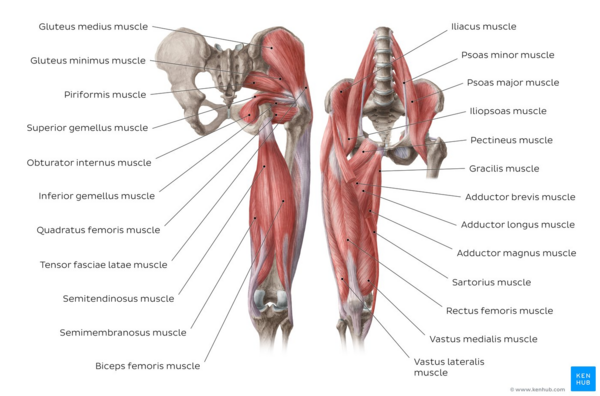Thomas Test
Original Editor - Tyler Shultz
Top Contributors - Aurelie Canas Perez, Maddison Jones, Ashtyn Madden, Admin, Kim Jackson, Magdalena Hytros, Shelby Morrison, Joao Costa, Rachael Lowe, Lucinda hampton, Tyler Shultz, Johnathan Fahrner, Yvonne Yap, Kevin Campion, Tony Varela, Matt Huey, Kai A. Sigel, Leana Louw, Sue Safadi, Oyemi Sillo, Naomi O'Reilly, Adam Vallely Farrell and Wanda van Niekerk
Purpose[edit | edit source]
The Thomas Test is used to measure the flexibility of the hip flexors.[1]
- Impaired range of motion of the hip may be an underlying cause to other conditions such as: psoas syndrome; patellofemoral pain syndrome[2]; lower back pain[3], osteoarthritis; rheumatoid arthritis.[4]
- Often associated with runners, dancers, and gymnasts who complain of hip "stiffness" and reported "snapping" feeling when flexing at the waist.[5]
Image: Overview of the hip and thigh - anterior and posterior views[6]
This 17 minute video is a good summary of the muscles of the hip and thigh.[7]
Relevant Anatomy[edit | edit source]
Hip flexors perform various functions, and some cross over more than one joint. They consist of the iliopsoas (psoas and iliacus), rectus femoris, sartorius, tensor fasciae latae, pectineus, gracilus, adductors and a gluteus muscles.
- The iliopsoas muscle that has the strongest pull and compressive effect on our spine. It is attached to the L1-L5 and T1 vertebrae. A tight psoas often compresses the spine and the discs associated.
- A chronic state of shortening can lead to low back pain.[8]
There are various muscles making up the hip flexor group being tested in the Thomas Test:
| Iliopsoas muscle group |
Main Function |
Additional movement |
| Iliopsoas |
Hip flexion |
External rotation |
| Rectus femoris |
Hip flexion |
Knee extension |
| Tensor fascia lata |
Hip flexion |
Internal rotation, abduction |
| Sartorius |
Hip flexion |
Knee flexion |
Technique[edit | edit source]
- Patient is supine ,with lower gluteal folds at the end of the table and their hips and knees flexed. (Patient may hold the legs in flexion with their hands).
- Therapist makes sure that the patient’s lower back is in a neutral pelvic tilt.
- Patient keeps the unaffected leg flexed, and slowly lowers the affected leg and lets it extend as far as it can.[8]
Interpretation[edit | edit source]
Thomas test: The following structures may be considered during a positive test.[9]
| Sign | Structures affected |
|---|---|
| Extended knee | Quadriceps, rectus femoris |
| Flexed hip | Psoas muscles |
| Abducted hip | Tensor fascia lata, iliotibial band |
| Tibia lateral rotation | Biceps femoris |
A modified version of the test is one in which the patient lies down on their back, at the very edge of the table, with both legs hanging freely. The patient must then flex their knee and pull it back to their chest as close as they can, using both arms while doing so. The other leg can hang The lumbar spine must remain flat and in contact with the table during the test. The second video below shows technique.
Viewing[edit | edit source]
An easy test to perform, as shown in this 40 second video.
Thomas Test video provided by Clinically Relevant
This 40 second video shows the modified test.
Reliability[edit | edit source]
Studies that test the reliability of the Thomas study are very limited.
- One study has demonstrated that the modified Thomas test has a very good inter-rater reliability.[11] Another has demonstrated that the modified Thomas test, has an average of only moderate levels of reliability.[12] Further research is required to prove or to refute the reliability of the Thomas test.
- Peeler & Anderson conducted a study in 2006 examining the reliability of the Thomas test for assessing hip range. Their study calls into question the reliability of the technique when used to score range of motion and iliopsoas muscle flexibility about the hip joint using both goniometer and pass/fail scoring methods.[13]
References[edit | edit source]
- ↑ Harvey D. Assessment of the flexibility of elite athletes using the modified Thomas test. British Journal of Sports Medicine 1998;32(1):68-70.
- ↑ Tyler TF, Nicholas SJ, Mullaney MJ, McHugh MP. The role of hip muscle function in the treatment of patellofemoral pain syndrome. The American journal of sports medicine 2006;34(4):630-6.
- ↑ Marrè-Brunenghi G, Camoriano R, Valle M, Boero S. The psoas muscle as cause of low back pain in infantile cerebral palsy. Journal of Orthopaedics and Traumatology 2008;9(1):43-7.
- ↑ Adams JC, Hamblen DL. Outline of Orthopaedics. 13th edition. Churchill Livingstone, 2001. p.459.
- ↑ OrthoFixar Thomas test Available: https://www.orthofixar.com/special-test/thomas-test/(accessed 18.1.2022)
- ↑ Overview of the hip and thigh - anterior and posterior views image - © Kenhub https://www.kenhub.com/en/library/anatomy/hip-and-thigh-anatomy
- ↑ Muscles of the hip and thigh video - © Kenhub https://www.kenhub.com/en/library/anatomy/hip-and-thigh-anatomy
- ↑ 8.0 8.1 Special tests Thomas Test Available:https://special-tests.com/hip-pelvis-tests/thomas-test/ (accessed 18.1.2022)
- ↑ Medical Dictionary Thomas Test Available:https://medical-dictionary.thefreedictionary.com/Thomas+test (accessed 18.1.2022)
- ↑ Liverpool Chiropractic & Sports Injury Clinic. Hip Mobility Assessment | Modified Thomas Test. Available from https://www.youtube.com/watch?v=9fdHMryWbpI (accessed 28/11/2020).
- ↑ Gabbe BJ, Bennell KL, Wajswelner H, Finch CF. Reliability of common lower extremity musculoskeletal screening tests. Physical Therapy in Sport 2004;5(2):90-7.
- ↑ Clapis PA, Davis SM, Davis RO. Reliability of inclinometer and goniometric measurements of hip extension flexibility using the modified Thomas test. Physiotherapy theory and practice 2008;24(2):135-41.
- ↑ Peeler J, Anderson JE. Reliability of the Thomas test for assessing range of motion about the hip. Physical Therapy in Sport. 2007;8(1):14-21.







